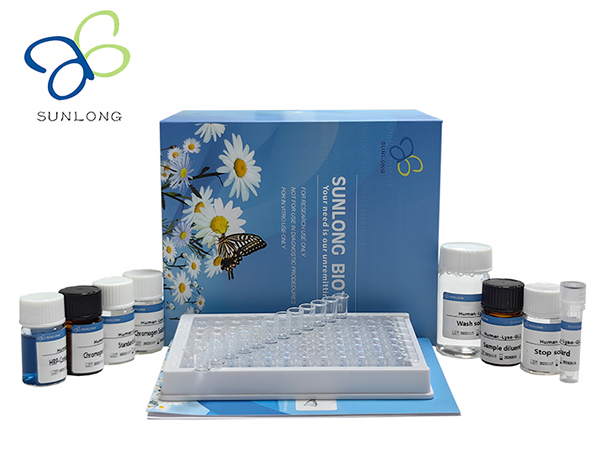Human Aflatoxin Albumin Adduct (AFT-HSA)ELISA Kit
Catalog No :
CAS Number :
Brand :
In Stock
Specifications:
| Application | ELISA-Based Assays | ||
| Storage Temperature | 2-8°C | ||
| Product Type | Elisa Kit | Forms | Kit with Various components |
| Product Grade | Molecular Biology | ||
The Human Aflatoxin Albumin Adduct (AFT-HSA) ELISA Kit is a quantitative sandwich ELISA assay designed for the detection and measurement of AFT-HSA levels in human serum, plasma, culture media, or other biological fluids. This high-sensitivity research-use-only assay utilizes an HRP-conjugated detection system to generate a colorimetric reaction proportional to the concentration of AFT-HSA in the sample.
The assay is designed for reliable, precise, and reproducible results in research applications involving mycotoxin exposure assessment, toxicology studies, and biomarker validation.
Key Features & Benefits
1. High Sensitivity & Wide Dynamic Range
- Assay range: 0.5 ng/mL – 40 ng/mL
- Sensitivity: 0.1 ng/mL
- Accurate detection of AFT-HSA in biological samples
2. Reliable & Reproducible Results
- Intra-Assay Precision (CV <10%) ensures consistent results within the same assay
- Inter-Assay Precision (CV <12%) ensures reproducibility across different assay runs
- Standards included for generating a reliable standard curve
3. User-Friendly & Ready-to-Use Components
- Pre-coated microplate with specific antibodies for AFT-HSA detection
- Ready-to-use reagents, standards, and controls for ease of use
- Step-by-step instructions for accurate sample preparation and analysis
Assay Principle
This sandwich ELISA uses a pre-coated microplate with an anti-AFT-HSA antibody to capture AFT-HSA in the sample. The assay follows these steps:
- Sample or standard is added to the wells and binds to the coated antibody.
- HRP-conjugated secondary antibody is added and binds to the captured AFT-HSA.
- Washing steps remove unbound components.
- Chromogen Solution A and B are added, generating a color reaction.
- Stop solution is added to halt the reaction.
- Optical density (OD) is measured at 450 nm, with OD values proportional to AFT-HSA concentration.
Kit Components & Storage Conditions
| Component | Quantity | Storage |
|---|---|---|
| User manual | 1 | Room temperature |
| Closure plate membrane | 2 | Room temperature |
| Sealed bags | 1 | Room temperature |
| Microelisa strip plate | 1 (96 wells) | 2-8°C |
| Standard (54 ng/mL) | 0.5 mL × 1 bottle | 2-8°C |
| Standard diluent | 1.5 mL × 1 bottle | 2-8°C |
| HRP-conjugate reagent | 6 mL × 1 bottle | 2-8°C |
| Sample diluent | 6 mL × 1 bottle | 2-8°C |
| Chromogen Solution A | 6 mL × 1 bottle | 2-8°C |
| Chromogen Solution B | 6 mL × 1 bottle | 2-8°C |
| Stop solution | 6 mL × 1 bottle | 2-8°C |
| Wash solution (30X) | 20 mL × 1 bottle | 2-8°C |
Storage & Validity
- Store all reagents at 2-8°C
- Avoid repeated freeze-thaw cycles
- Kit is valid for six months from the date of manufacture
Sample Preparation Guidelines
1. Serum Preparation
- Collect whole blood and allow it to clot at room temperature (10-20 min).
- Centrifuge at 2,000-3,000 rpm for 20 minutes.
- Collect supernatant (serum) and store at -20°C if not used immediately.
2. Plasma Preparation
- Collect whole blood using EDTA or citrate anticoagulant tubes.
- Centrifuge at 2,000-3,000 rpm for 20 minutes.
- Collect plasma and store at -20°C if not used immediately.
3. Urine, Cerebrospinal Fluid, and Other Fluids
- Centrifuge at 2,000-3,000 rpm for 20 minutes.
- Collect supernatant and store at -20°C if needed.
4. Cell Culture Supernatant
- Centrifuge at 2,000-3,000 rpm for 20 minutes to remove debris.
- Collect supernatant and store at -20°C.
5. Tissue Homogenates
- Homogenize tissue in PBS (pH 7.4) at 4°C.
- Centrifuge at 2,000-3,000 rpm for 20 minutes and collect supernatant.
Assay Procedure
- Dilution of Standards: Prepare standards from 54 ng/mL down to 3 ng/mL using the standard diluent.
- Sample Addition: Add 40 µL of sample dilution buffer and 10 µL of sample to each well (except blank control).
- Incubation: Cover plate and incubate at 37°C for 30 minutes.
- Washing: Wash wells five times with 1X diluted wash buffer.
- HRP Conjugate Addition: Add 50 µL of HRP-conjugate reagent to each well (except blank).
- Incubation & Washing: Incubate at 37°C for 30 minutes, then repeat the wash step.
- Color Development: Add 50 µL Chromogen Solution A and 50 µL Chromogen Solution B to each well.
- Incubation: Incubate at 37°C for 15 minutes in the dark.
- Stop Reaction: Add 50 µL stop solution; color will change from blue to yellow.
- Read OD: Measure at 450 nm using a microplate reader.
Calculation of Results
- Standard Curve: Plot OD values vs. known AFT-HSA concentrations on a log-log scale.
- Sample Calculation: Determine unknown sample concentration using the standard curve.
- Dilution Factor: Multiply the final concentration by the sample dilution factor (X5) if necessary.
Performance Characteristics
| Parameter | Details |
|---|---|
| Assay Range | 0.5 ng/mL – 40 ng/mL |
| Sensitivity | 0.1 ng/mL |
| Intra-Assay CV | < 10% |
| Inter-Assay CV | < 12% |
Precautions & Notes
- All samples and reagents should be equilibrated to room temperature before use.
- Avoid cross-contamination by using fresh pipette tips and disposable microplate sealers.
- Protect substrate solutions from light to maintain reagent stability.
- Reagents from different lot numbers should not be mixed.
- All waste and samples should be handled as potentially biohazardous materials.
The Human Aflatoxin Albumin Adduct (AFT-HSA) ELISA Kit is a high-sensitivity sandwich ELISA for the quantitative detection of AFT-HSA in biological samples. With a broad assay range, high specificity, and robust performance, this kit is a valuable tool for mycotoxin exposure assessment, toxicology research, and biomarker studies.




 0
0
